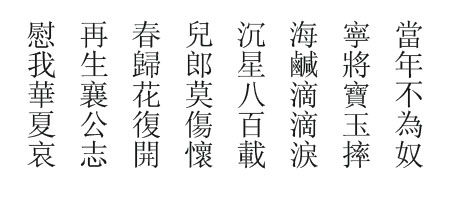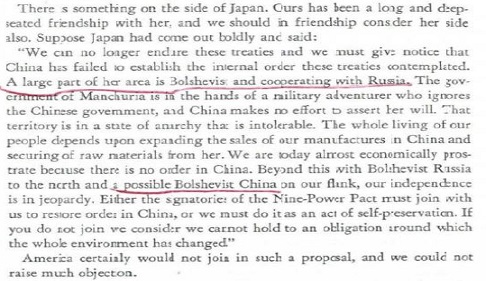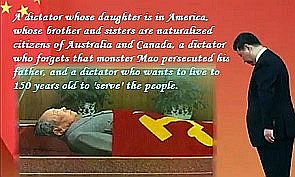In the spring of 1945, the Chinese communists, prior to the Soviets' non-renewal or nullification of the 13 April 1941 neutrality treaty with Japan, had debated among themselves as to the next move but were split about Stalin's possible move, namely, whether the Soviets would renew the treaty with Japan or not, with communist Chen Yi giving Jack Service a so-called [explorative] "Manchuria Plan", a document that some undercover American communist in the American military delegation had destroyed to help cover up the so-called communist masterplan --something Jack Service cited as his loyalty before the McCarthy inquisition committee in the 1950s.
It would be at the turn of September-October of 1945, when Mao was in Chungking for the peace talks, that communist deputy chief Liu Shaoqi changed Mao's southern advance masterplan to the Manchuria plan.
The Communist party committee for the Hebei-Rehe-Liaoning regions, at a meeting held in the Fenglunxian County, purportedly made a decision to dispatch to Manchuria 8 regiments, 1 battalion, and two contingents, totaling 13,000 men or 2/3rd of the regional force, to be commanded by four commanders for military sub-districts, four CCP regional secretaries and 2500 cadres.
Li Yunchang, i.e., commander-in-chief of the Hebei-Rehe-Liaoning district, was put in charge of the "Eastward March Work Committee".
In late Aug, the 14th, troops of the 15th & 16th military sub-districts under Li Yunchang exited the passes of the Great Wall for Manchuria.
Zeng Kelin & Tang Kai, with the 12th & 18th regiments, the Korean contingent & Lin Fuchang's contingent, circumvented the Shanhaiguan Pass by exiting the Jiumenkou gate.
Zeng Kelin had only four companies' strength, not a regiment.
Upon meeting the Soviet Red Army, Zeng Kelin's ragged communist army herald troops were disarmed by the Soviets as bandits.
Li Yunchang, in late 1945, suffered a complete debacle in the hands of the nationalist 52nd Corps and the 13th Corps, with his 40,000 strong communist army reduced to 5000 men after the Battle of Jinzhou. (Don't get obfuscated by the fake number of 1.2 million communist troops [such as Li Yunchang's ragtag puppets-staffed 40,000 troops which were reduced to 5000 men after the 1945 Battle of Jinzhou], that Mao wanted Chiang Kai-shek to reorganize into 16th corps or 48 divisions at the Chungking peace conference.)

Zeng Kelin joined the Red Army as a sixteen-year kid in the late 1920s.
Li Yunchang was a Hebei-Jehol native who was recommended to the Whampoa Academy by Li Dazhao, lost contact with the communists after a brief arrest during the KMT-CCP split of 1927, and returned to the hometown where he reconnected with the communists prior to the 1937 Japanese invasion.
In another word, Li Yunchang was part of the communist cells related to the 1936 Japanese "anti-communist" puppet government in Tongzhou.
Li Yunchang, like communist Tao Zhu, was rounded up as part of the communist elements in the Whampoa Academy.
It appeared that the communists safely left the Whampoa Island rather than being machine-gunned down as the communist propaganda stated.
Before the communists launched the Canton Mutiny, over one hundred communist Whampoa cadets, including Tao Zhu, escaped prison after some clandestine manipulation to get the hundred plus captives transferred to the city from the Whampoa Island.)
The Korean contingent, which was later renamed to the Li Hongguang Detachment, was named after a Korean communist who died in 1935, possibly hinting at the members of this force to be consisting of part of the Korean Restoration Army that was steered to the communist side by the American O.S.S.
What could have happened was that the cadres of the Korean Restoration [Liberation] Army, now controlling the "Li Hongguang [Korean] Detachment", were to become the military leaders of
250,000 Korean mercenaries,
i.e., 250,000 ethnic-Korean Japanese Kwantung Army diehards or the prisoners of war
repatriated to North Korea from Siberia,
with 60,000-70,000 survivors to return to Korea in 1950 to be the driving force for the invasion of South Korea, namely, the ultimate Yenan faction that Kim Il-sung destroyed in the late 1950s for consolidating the Kim Dynasty.
Stalin, in addition to sorting out the 250,000 Korean puppet army troops, had sent all Taiwan-ethnic Japanese Kwantung Army soldiers to Mao Tse-tung.
The end result was that the Korean-ethnic and Taiwan-ethnic Japanese army manned the artilleries and tanks against the Republic of China.
How ironic it was.
Note that the Jehol area used to be the guerrilla army under Youth Party leader Zhao Tong who fought against the Japanese since 1931-1932. To prevent Zhao Tong's Jehol Vanguard Army, about 200-300 men and women, from returning to Jehol from Chungking, the communist armies, with advance information from communist leader Zhou Enlai who superficially participated in the farewell ceremony for the march of the vanguard army in Chungking, pooled resources all over the military districts including Heh Long's communist army from northwestern Shanxi and Suiyuan area, and ambushed and eliminated the vanguard army in the tri-provincial area of Shanxi-Henan-Hebei around the turn of 1939-1940.
The communists, in the Chahar-Suiyuan area and around Mt. Daqingshan [the great green mountain], had conducted similar horrifying campaign against the patriotic guerrilla forces, including the fire attack that killed a 90-year-old former Northeastern Cavalry Army corps commander and his guerrilla army, and furthermore attacked and eliminated KMT party operator Chen Jianzhong's party-directly-controlled guerrilla forces and all couriers who were sent through the communist-controlled territories of Shanxi-Shenxi, with Chen Jianzhong being the sole survivor to return to Chungking in disguise.
According to Liu Tong, a professor at the Chinese Communists' army college in Peking, the CPC troops, when exiting the Sea and Mountain Pass at the end of 1945, possessed the following weapons: 39641 rifles, 1139 light machine guns, 105 heavy machine guns, 59 grenade launchers, and 64 mortar, and almost no heavy weapons such as howitzers, tanks, aircraft, ... nothing. A few months later, the communist army acquired 160,881 rifles, 4033 light machine guns, 749 heavy machine guns, and a variety of artillery pieces numbering 556.
(The number of 39641 rifles, being like one fourth of the total 140,000 broken guns that Mao Tse-tung initially said he had at the Chungking peace talks, were not for the Jehol military district but the total communist armies sent to Manchuria, including the 8RA and N4C armies that crossed the sea to Manchuria from the Shandong peninsula.
After eight years' war, what a sham the communist army was in merely possession of 39641 rifles.)
In late September of 1945, when Zeng Kelin's herald communist troops, a small force of four companies from the Jehol district, exited the Sea and Mountain Pass and arrived in Shenyang [Mukden], the Soviet Army had transferred arsenals in Shenyang, Fushun, Liaoyang, Benxi and other places, in addition to the military clothing warehouses. The Soviets handed over to Zeng Kelin's communist army the largest of the Japanese Kwantung Army depot in Sujiatun. After a protest from the R.O.C., the Soviet Army in late September had a temporary freeze order on these warehouses. However, Zeng Kelin's communist army still managed to ship out of the warehouses 20,000 rifles, 1000 light machine guns, and 156 various artillery pieces.
Zeng Kelin's forerunner Communist force, i.e., four companies, developed into 4000 soldiers in a matter of one week after arrival at the Shenyang city, and moreover, absorbed over 10,000 puppet constabulary forces; about 10000-20000 coolies, who were formerly captives from the Chinese armies, were organized into the guerrilla columns for entry into the Changchun city; in Shenyang, Zeng Kelin reported that weapon depots were packed with 100,000 guns and thousands of cannons; and the puppet Manchukuo forces were in waiting mode for re-organization.
(The communist army, of course, was totally destroyed after the Battle of Siping-jie, with the puppet Manchuria army and constabulary troops defecting to the government side en masse.
The communists had to launch a bloody land reform to reorganize an army in 1947, plus requesting for reinforcements with Kim Il-sun [who in his memoirs claimed to have supplied altogether 250,000 Koreans to the Chinese civil war].)
In a matter of months, the various communist units, before and after, had a net gain of more than 120,000 rifles, 3,500 light machine guns, thousands of grenade launchers, and a variety of artillery in the amount of 492 pieces.
The continuous Soviet military supplies not only equipped the communists in Manchuria, but also lent support to the follow-up communist forces, local communist guerrillas, as well as the communist army units in the "liberated" areas [in China proper].
Zeng Kelin's communist army in October 1945 pulled out of the warehouses for delivery to [Wang Zheng's] 359th Brigade [in Yenan - should be part of Li Xiannian's Central Plains communist army in Henan, that got wiped out in early 1947 while attempting a breakout under the kmt-ccp-u.s.a. truce monitoring], the communist army in central Shandong and eastern Shandong, the 1st Teaching Brigade from Yan'an and other troops.
Over the sea, the communists shipped to Longkou of Shandong a batch of weapons, ammunition, of which there were 500 million rounds of ammunition, and artillery shells.
On September 21, 1945, the CCP Central [in Yenan] reported to the Chongqing delegation [i.e., Mao Tse-tung], stating that Nie Rongzhen's Jin-Cha-Ji District had telegrams stating that the Soviet-Mongol armies, before pulling out of Chahar [[and of course Jehol - my addition]] that was scheduled for the end of the month, had transferred and would transfer some military goods to me [i.e., the communists], and promised to provide assistance to me [i.e., the communists] in the future.
There were quite some telegrams from Nie Rongzhen's Jin-Cha-Ji District and the Shanxi-Suiyuan communists to the effect that they had acquired weapons from the Soviet Army.
As Zeng Kelin recalled, in September and October 1945, his [communist] unit had more than once shipped massive amount of weapons and ammunition, from Shenyang and Jinzhou [in Manchuria], to the communist brotherly forces within the Sea and Mountain Pass and the communist forces of Shandong [i.e., Chen Yi and Su Yu's communist army].
TEN TRAINS EQUIVALENT AMERICAN LEND-LEASE WEAPONS THAT STALIN & RUSSIANS GAVE TO MAO & CHINESE COMMUNISTS;
FORTY SHIPS EQUIVALENT QUANTITY OF TANKS & CANNONS, BOTH AMERICAN-MADE & JAPAN-MADE
3300 TONS OF PETROL FROM RUSSIANS IN 1947 ALONE; PLUS 2000 TONS OF DIESEL, 1000 TONS OF PLANE FUEL, 700 TONS OF EXPLOSIVES & 2000 TONS OF MACHINERY OIL
30000 TONS OF PETROL FROM RUSSIANS IN 1948; PLUS 1000 TONS OF PLANE FUEL, 5000 TONS OF KEROSINE, 3000 HEAVY WEIGHT TRUCKS & 150 ARTILLERY TRACTORS
DEATH OF MILLIONS OF YELLOW MEN, & POSSIBLY MORE IN THE FUTURE WAR AGAINST TAIWAN !!!!!
Reference: see the writing by James Perloff China Betrayed Into Communism on Friday, 24 July 2009 at
http://www.thenewamerican.com/index.php/history/world/1464
August Storm lend-lease weapons ended up in Mao's hands.
"At the Teheran and Yalta wartime conferences, however, Roosevelt asked Stalin if he would break his pact with Japan and enter the Far East war. Stalin agreed, but attached conditions. He demanded that America completely equip his Far Eastern Army for the expedition, with 3,000 tanks, 5,000 planes, plus all the other munitions, food, and fuel required for a 1,250,000-man army. Roosevelt accepted this demand, and 600 shiploads of Lend-Lease material were convoyed to the USSR for the venture. Stalin's Far Eastern Army swiftly received more than twice [should be 5-10 times] the supplies we gave Chiang Kai-shek during four years as our ally.
"General Douglas MacArthur protested after discovering that ships designated to supply his Pacific forces were being diverted to Russia. Major General Courtney Whitney wrote: 'One hundred of his transport ships were to be withdrawn immediately, to be used to carry munitions and supplies across the North Pacific to the Soviet forces in Vladivostok.... Later, of course, they were the basis of Soviet military support of North Korea and Red China.'
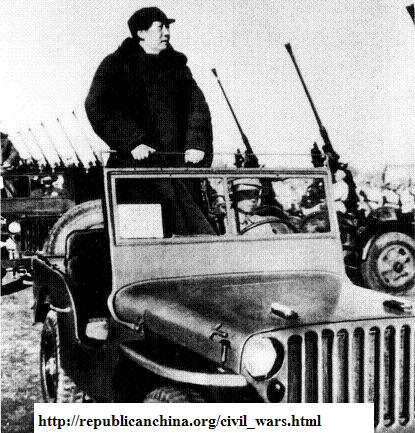
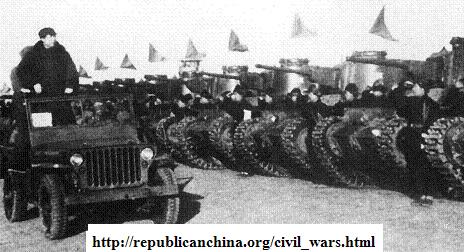
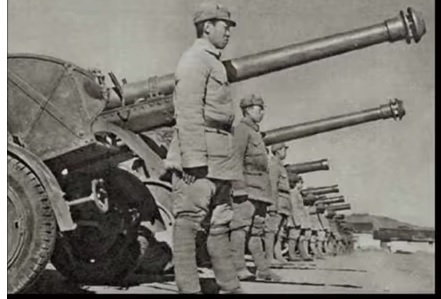
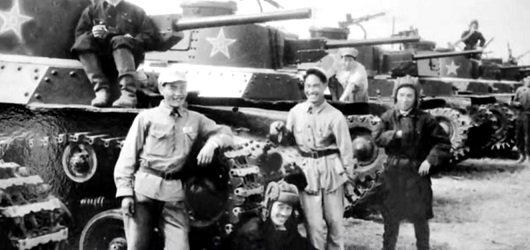
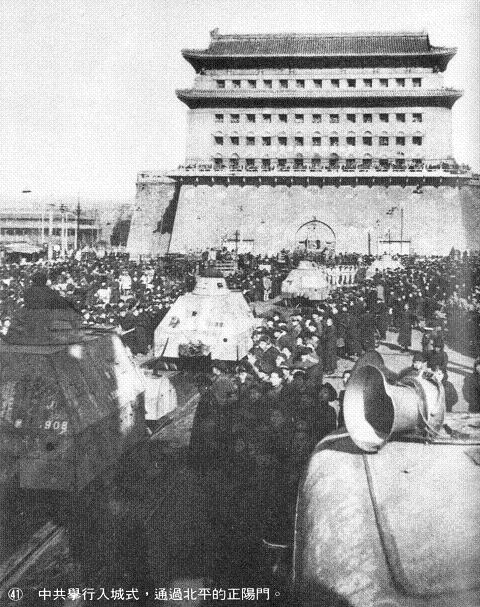
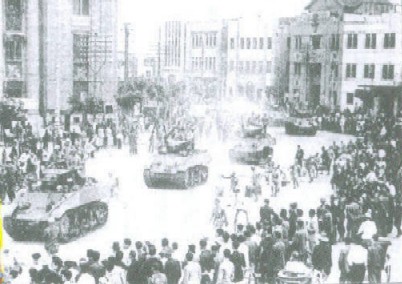 The pseudo-encyclopedia website like wikipedia also made the fallacious claim that would make the Chinese communists laugh to the teeth:
"However, the nearly nonexistent Soviet help proved not to be a problem for the Communists; in the meantime, the huge Communist need was filled by an unexpected source: their adversaries, the Nationalists. Due to the fatal mistake the Nationalists made in their demilitarization, the Communists were able to pinpoint nearly every Japanese secret depot with the help of former Nationalist troops in their ranks, and the total amount of Japanese weaponry recovered was enough to sustain the Communists for 2 years before relying on captured American weaponry from the Nationalists in the later stage of the war. For example, a single secret depot typically contained as much as 150,000 artillery rounds. By February 1947, hundreds of artillery pieces were recovered by the communists, including: 49 howitzers, 300 heavy mortars, 137 anti-aircraft artilleries, 141 anti-tank guns, 108 mountain guns, 97 cannons, and many other smaller artillery pieces, almost one-third of the Nationalist weaponry."
The pseudo-encyclopedia website like wikipedia also made the fallacious claim that would make the Chinese communists laugh to the teeth:
"However, the nearly nonexistent Soviet help proved not to be a problem for the Communists; in the meantime, the huge Communist need was filled by an unexpected source: their adversaries, the Nationalists. Due to the fatal mistake the Nationalists made in their demilitarization, the Communists were able to pinpoint nearly every Japanese secret depot with the help of former Nationalist troops in their ranks, and the total amount of Japanese weaponry recovered was enough to sustain the Communists for 2 years before relying on captured American weaponry from the Nationalists in the later stage of the war. For example, a single secret depot typically contained as much as 150,000 artillery rounds. By February 1947, hundreds of artillery pieces were recovered by the communists, including: 49 howitzers, 300 heavy mortars, 137 anti-aircraft artilleries, 141 anti-tank guns, 108 mountain guns, 97 cannons, and many other smaller artillery pieces, almost one-third of the Nationalist weaponry."
During the peace talks, Mao Tse-tung initially mentioned that he had 140000 to 150000 broken guns --which was exactly what VLADIMIROV DIARIES had repeatedly tallied about the communist strength of a little over 300,000 men at the time Japan surrendered.
After receiving the telegrams from Liu Shaoqi in regards to the massive Soviet military assistance, Mao Tse-tung changed tune about the communist army's real strength at the Chungking peace talk meetings.
Mao Tse-tung also concurred with Liu Shaoqi about changing Mao's grand strategy of re-launching the Soviet enclaves in southern China to go full in to Manchuria.
Mao Tse-tung, at one time, agreed to contract to 28 divisions instead of 12 divisions [which they possessed on paper only, as we already pierced the myth that the Communists ever possessed 300,000+ troops at the time of the
Japanese surrender], but later demanded that he maintained 48 divisions and that the Nationalist Government provide the funding.
Mao Tse-tung further demanded that in the CCP-"liberated" areas, the CCP had the right to recommend their men for the jobs like provincial governor, county magistrate and city mayor.
Without reaching agreements on the "united military command" and the "united administrative orders", Chiang Kai-shek and Mao Tse-tung reached a "Double Tenth" (Oct 10th, 1945) Agreement requiring that the KMT discontinue "xun zheng' (i.e., the KMT supervised administration) and convene a political consultative meeting for "xian zheng" (i.e., the constitutional government).
Later, when the national assembly was held to return the rule to the constitutional government, the Chinese communists refused to join the election.
(FYI: Mao Tse-tung's claim of 1.2 million Communist forces was a crap. The Communists did not have a third of it until well after the Japanese surrender in 1945. The only motive of exaggerating the fake number would be to claim a non-existent Mandate, i.e., support from the peasants, which was fallacious since the Jiangxi Soviet of the 1930s. The popular claim of 900k regular and 2 million irregular was made up as well.
At the end, when Japan surrendered, the communists possessed an army of merely 300,000 and the total number of 140,000 rotten guns --Mao's words.
Don't get obfuscated by the fake number of 1.2 million communist troops [such as Li Yunchang's ragtag puppets-staffed 40,000 troops which were reduced to 5000 men after the 1945 Battle of Jinzhou], that Mao wanted Chiang Kai-shek to reorganize into 16th corps or 48 divisions at the Chungking peace conference.
The Soviet archives, which tracked the actual Chinese communist army headcounts throughout the 1920s to 1940s, had the real numbers that pierced the fabricated myth.)
The Communists declined Chiang Kai-shek's demand for the "united military command" and the "united administrative orders", claiming that they were for the 'peace' and 'democracy' while Chiang Kai-shek intended for the 'civil war' and 'dictatorship'. Mao Tse-tung merely agreed to concession of the Communist-controlled untenable guerrilla enclave areas of Guangdong Province, Zhejiang Province, southern Jiangsu Province, central Anhui Province, southern Anhui Province, Hunan Province, Hubei Province and Henan Province. Militarily, Mao Tse-tung agreed to compress to 48 and consecutively 43 divisions, so that the Communist forces would be amounting to 1/6th and consecutively 1/7th the size of 263 government troops divisions. Chiang Kai-shek stated that they intended to compress the army to 120 divisions, but the Communists refused to lower to 20 divisions.
While Marshall was scheming to impose an arms embargo against the Republic of China, the Soviets hastened up their military support for the Chinese communists.
On May 20, 1946, the CCP Northeast Bureau reported to the CCP Central that the Soviet Russian Army firmly supported the communist Northeast Field Army to make a stand at Siping, for a duel, and they had directed the Soviet Army in [North] Korea to render the immediate emergency shipment of ammunition [to the Chinese Communist armies], and further suggested that the Chinese Communists, for taking off the pressure of the government troops' assault [on Siping and] within the Northeast, [proactively - I added] launch the battlefields within the China proper, organize the maritime transport for the delivery of weapons and ammunition to the Shandong peninsula from the northeast. The Soviets claimed that no matter how much weapons and ammunition the Chinese Communists demand, they would be satisfied. Immediately afterwards, the Soviet Army in Communist North Korea provided the first batch of weapons and ammunition to the communist North China Field Army. On May 28, 1946, the first batch of 82 light machine guns, 32 heavy machine guns, 43 million rounds of ammunition and one million boxes of explosives and a large number of electrical materials, were shipped to Shandong over the sea. Already in early June to late in the month, there were three deliveries. Afterwards, the delivery became more frequent, the numbers even greater. By August, the rifles had reached tens of thousands, up to thousands of machine guns, and at the height [until August 1946], the Soviet Army in North Korea provided hundreds of train carriages of weapons and ammunition.
|
|





